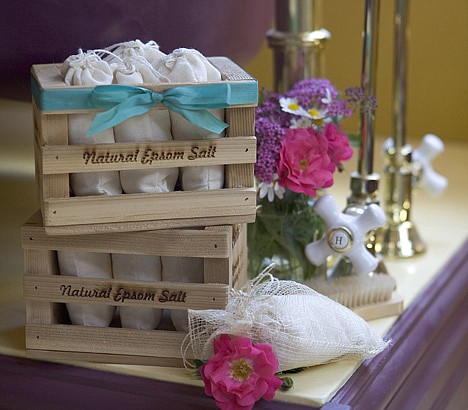Epsom salt - forgotten but not gone
Today, Epsom salt has become an almost forgotten folk remedy -- something that might crop up among the creased and yellowing pages of a farmer's almanac. Sure, you can still find it on pharmacy shelves just about anywhere, but what the heck is this stuff, and what is it used for? These days, most people regard it as a medicinal soak for things like sore feet or insect bites. And, yes, it works wonders for both, but that is only the beginning. This multipurpose miracle salt can help cultivate internal and external wellbeing, and it is also a great go-to ingredient for happy gardens and houseplants.
What is it?
Unrelated to table salt, Epsom salt (also known as magnesium sulfate) was originally discovered in mineral waters bubbling from a spring at Epsom in Surrey, England. It is a crystallized mineral compound of magnesium and sulfur - both essential to human wellness - that is naturally present in seawater and brine pools.
Health and beauty booster
Many people's diets today are deficient in magnesium and sulfates, minerals that can be hard to come by when processed foods dominate grocery stores and restaurants. Enter Epsom salt. Magnesium and sulfates are absorbed right through the skin when we soak in a bath of Epsom salt, and so while we're luxuriating in a warm tub, our bodies are benefiting from a boost in circulatory health and nerve function, as well as a reduction in muscle pain and inflammation. Not to mention, Epsom salt is a natural emollient for our skin. Unlike other salts, it leaves the skin feeling soft and silky rather than dry. Here are a few ways to take advantage:
Soothing Soak: Add 2 cups of Epsom salt to your bath to soak sore muscles, soothe bug bites, speed the healing of bruises and help remove splinters.
Foot Bath: Add 1 cup of Epsom salt to a basin of warm water as a balm for aching feet.
Skin Scrub: Rub a handful of Epsom salt over wet skin for deep cleansing and smoother skin. Rinse and pat dry.
Bath Crystals: Mix 2 cups of Epsom salt with a few drops of essential oil to create custom bath crystals. Store in an airtight container.
Laxative: Yes! It can even help with occasional constipation. (Follow directions provided by a pharmacy.)
Green Garden Ingredient
Did you know that Epsom salt can be used as a natural fertilizer? It is most commonly applied to potted plants, or to magnesium-hungry crops like potatoes, roses, tomatoes and peppers. The advantage of using magnesium sulfate over other magnesium soil amendments (such as dolomitic lime) is its high solubility - it melts right into the soil. Here's how to use it:
Houseplants: 2 tablespoons per gallon of water; feed plants monthly.
Tomatoes: 1 tablespoon per foot of plant height per plant; apply every 2 weeks.
Roses: 1 tablespoon per foot of plant height per plant; apply every 2 weeks. Also scratch 1/2 cup into soil at base to encourage flowering canes and healthy new basal cane growth. Spray with Epsom salt solution weekly to discourage pests.
Shrubs (evergreens, azaleas, rhododendron): 1 tablespoon per 9 square feet. Apply over root zone every 2 to 4 weeks.
Lawns: Apply 3 pounds for every 1,250 square feet with a spreader or dilute in water and apply with a sprayer.
Trees: Apply 2 tablespoons per 9 square feet. Apply over the root zone 3 times per year.
Garden Startup: Sprinkle 1 cup per 100 square feet. Mix into soil before planting.
How to buy and store
Epsom salt is produced in agricultural, technical, and food grades. Your best bet for safe use around the house and garden is to buy food grade (or USP grade). Mountain Rose Herbs offers pure Epsom salt that is sourced in the United States. Its coarse texture is great for creating exfoliating bath salts. Visit www.mountainroseherbs.com.
Epsom salt has a shelf life of about five years and stores well. (High humidity can cause it to cake, but will not affect its quality.)
Copyright 2010, MaryJane Butters. Distributed by United Feature Syndicate Inc.

